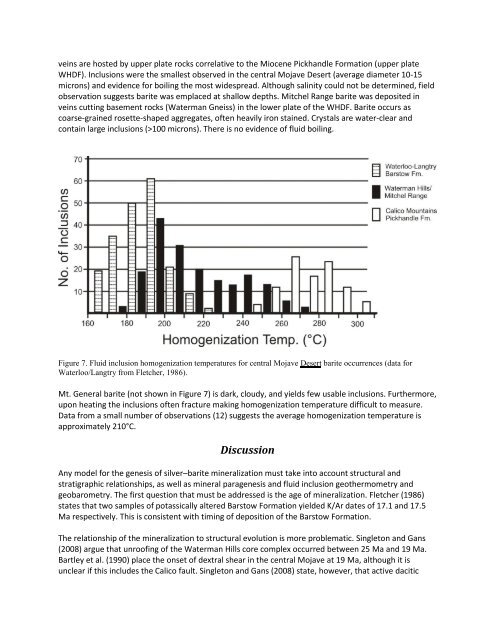Geology and Ore Genesis of Silver–Barite Mineralization in the ...
Geology and Ore Genesis of Silver–Barite Mineralization in the ...
Geology and Ore Genesis of Silver–Barite Mineralization in the ...
You also want an ePaper? Increase the reach of your titles
YUMPU automatically turns print PDFs into web optimized ePapers that Google loves.
ve<strong>in</strong>s are hosted by upper plate rocks correlative to <strong>the</strong> Miocene Pickh<strong>and</strong>le Formation (upper plate<br />
WHDF). Inclusions were <strong>the</strong> smallest observed <strong>in</strong> <strong>the</strong> central Mojave Desert (average diameter 10-15<br />
microns) <strong>and</strong> evidence for boil<strong>in</strong>g <strong>the</strong> most widespread. Although sal<strong>in</strong>ity could not be determ<strong>in</strong>ed, field<br />
observation suggests barite was emplaced at shallow depths. Mitchel Range barite was deposited <strong>in</strong><br />
ve<strong>in</strong>s cutt<strong>in</strong>g basement rocks (Waterman Gneiss) <strong>in</strong> <strong>the</strong> lower plate <strong>of</strong> <strong>the</strong> WHDF. Barite occurs as<br />
coarse-gra<strong>in</strong>ed rosette-shaped aggregates, <strong>of</strong>ten heavily iron sta<strong>in</strong>ed. Crystals are water-clear <strong>and</strong><br />
conta<strong>in</strong> large <strong>in</strong>clusions (>100 microns). There is no evidence <strong>of</strong> fluid boil<strong>in</strong>g.<br />
Figure 7. Fluid <strong>in</strong>clusion homogenization temperatures for central Mojave Desert barite occurrences (data for<br />
Waterloo/Langtry from Fletcher, 1986).<br />
Mt. General barite (not shown <strong>in</strong> Figure 7) is dark, cloudy, <strong>and</strong> yields few usable <strong>in</strong>clusions. Fur<strong>the</strong>rmore,<br />
upon heat<strong>in</strong>g <strong>the</strong> <strong>in</strong>clusions <strong>of</strong>ten fracture mak<strong>in</strong>g homogenization temperature difficult to measure.<br />
Data from a small number <strong>of</strong> observations (12) suggests <strong>the</strong> average homogenization temperature is<br />
approximately 210°C.<br />
Discussion<br />
Any model for <strong>the</strong> genesis <strong>of</strong> silver–barite m<strong>in</strong>eralization must take <strong>in</strong>to account structural <strong>and</strong><br />
stratigraphic relationships, as well as m<strong>in</strong>eral paragenesis <strong>and</strong> fluid <strong>in</strong>clusion geo<strong>the</strong>rmometry <strong>and</strong><br />
geobarometry. The first question that must be addressed is <strong>the</strong> age <strong>of</strong> m<strong>in</strong>eralization. Fletcher (1986)<br />
states that two samples <strong>of</strong> potassically altered Barstow Formation yielded K/Ar dates <strong>of</strong> 17.1 <strong>and</strong> 17.5<br />
Ma respectively. This is consistent with tim<strong>in</strong>g <strong>of</strong> deposition <strong>of</strong> <strong>the</strong> Barstow Formation.<br />
The relationship <strong>of</strong> <strong>the</strong> m<strong>in</strong>eralization to structural evolution is more problematic. S<strong>in</strong>gleton <strong>and</strong> Gans<br />
(2008) argue that unro<strong>of</strong><strong>in</strong>g <strong>of</strong> <strong>the</strong> Waterman Hills core complex occurred between 25 Ma <strong>and</strong> 19 Ma.<br />
Bartley et al. (1990) place <strong>the</strong> onset <strong>of</strong> dextral shear <strong>in</strong> <strong>the</strong> central Mojave at 19 Ma, although it is<br />
unclear if this <strong>in</strong>cludes <strong>the</strong> Calico fault. S<strong>in</strong>gleton <strong>and</strong> Gans (2008) state, however, that active dacitic

















